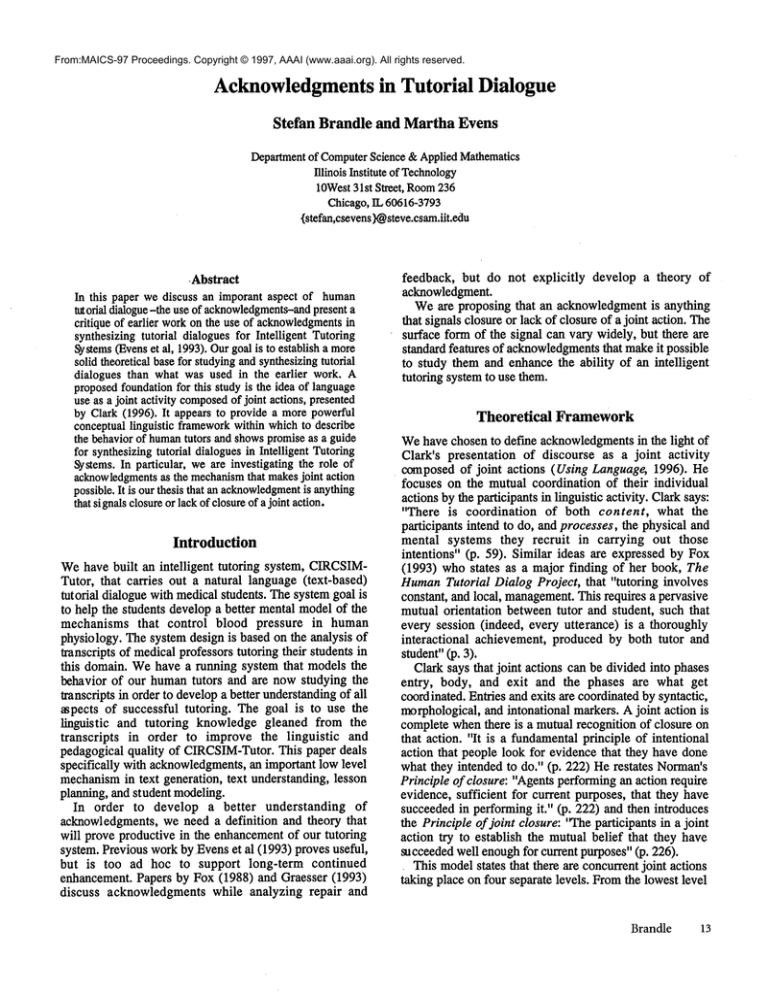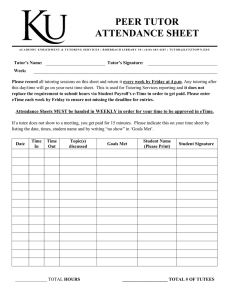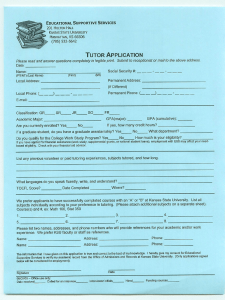
From:MAICS-97 Proceedings. Copyright © 1997, AAAI (www.aaai.org). All rights reserved.
Acknowledgmentsin Tutorial Dialogue
Stefan
Brandle
and Martha Evens
Departmentof ComputerScience &AppliedMathematics
Illinois Institute of Technology
lOWest31st Street, Room236
Chicago,IL 60616-3793
{stefan,esevens}@steve.csam.iit.edu
.Abstract
In this paper we discuss an imporant aspect of human
~orial dialogue-the use of acknowledgments-and
present a
critique of earlier workon the use of acknowledgments
in
synthesizing tutorial dialogues for Intelligent Tutoring
Systems(Evenset al, 1993).Ourgoal is to establish a more
solid theoretical basefor studyingand synthesizingtutorial
dialogues than what was used in the earlier work. A
proposedfoundationfor this study is the idea of language
use as a joint activity composed
of joint actions, presented
by Clark (1996). It appears to provide a morepowerful
conceptuallinguistic frameworkwithin whichto describe
the behaviorof humantutors and showspromiseas a guide
for synthesizingtutorial dialoguesin Intelligent Tutoring
Systems.In particular, we are investigating the role of
acknowledgments
as the mechanism
that makesjoint action
possible. It is our thesis that an acknowledgment
is anything
that signalsclosureor lack of closureof a joint action.
Introduction
Wehave built an intelligent tutoring system, CIRCSIMTutor, that carries out a natural language (text-based)
tutorial dialogue with medical students. The system goal is
to help the students develop a better mental modelof the
mechanisms that control blood pressure in human
physiology. The system design is based on the analysis of
transcripts of medical professors tutoring their students in
this domain. Wehave a running system that models the
behavior of our humantutors and are now studying the
Iranscripts in order to developa better understandingof all
aspects of successful tutoring. The goal is to use the
linguistic
and tutoring knowledge gleaned from the
transcripts
in order to improve the linguistic
and
pedagogical quality of CIRCSIM-Tutor.This paper deals
specifically with acknowledgments,an important low level
mechanismin text generation, text understanding, lesson
planning, and student modeling.
In order to develop a better understanding of
acknowledgments, we need a definition and theory that
will prove productive in the enhancementof our tutoring
system. Previous work by Evens et al (1993) proves useful,
but is too ad hoe to support long-term continued
enhancement. Papers by Fox (1988) and Graesser (1993)
discuss acknowledgments while analyzing repair and
feedback, but do not explicitly develop a theory of
acknowledgment.
Weare proposing that an acknowledgmentis anything
that signals closure or lack of closure of a joint action. The
surface form of the signal can vary widely, but there are
standard features of acknowledgments
that makeit possible
to study them and enhance the ability of an intelligent
tutoring system to use them.
Theoretical
Framework
Wehave chosen to defme acknowledgmentsin the light of
Clark’s presentation of discourse as a joint activity
composed of joint actions (Using Language, 1996). He
focuses on the mutual coordination of their individual
actions by the participants in linguistic activity. Clark says:
"There is coordination of both content, what the
participants intend to do, and processes, the physical and
mental systems they recruit in carrying out those
intentions" (p. 59). Similar ideas are expressed by Fox
(1993) who states as a major finding of her book, The
HumanTutorial Dialog Project, that "tutoring involves
constant, and local, management.This requires a pervasive
mutual orientation between tutor and student, such that
every session (indeed, every utterance) is a thoroughly
interactional achievement, produced by both tutor and
student"(p. 3).
Clark says that joint actions can be divided into phases
entry, body, and exit and the phases are what get
coordinated. Entries and exits are coordinatedby syntactic,
morphological, and intonational markers. A joint action is
complete whenthere is a mutual recognition of closure on
that action. "It is a fundamentalprinciple of intentional
action that people look for evidence that they have done
what they intended to do." (p. 222) He restates Norman’s
Principle of closure: "Agents performingan action require
evidence, sufficient for current purposes, that they have
succeeded in performing it." (p. 222) and then introduces
the Principle of joint closure: ’~lae participants in a joint
action try to establish the mutual belief that they have
succeededwell enoughfor current purposes" (p. 226).
This modelstates that there are concurrent joint actions
taking place on four separate levels. Fromthe lowest level
Brandle
13
to the highest, they are: 1) Speaker presents a signal and
addressees attend to signal. 2) Speaker signals something
to addressees, whoidentify the signal. 3) Speaker signals
that p, and addressees recognize that the speaker meansp.
4) Speakerproposes a joint project and the addressees take
up the proposal. (Clark, pp. 148-151). The action at each
these levels is performed in order to makepossible the
action at the next higher level, i.e. the speaker presents a
signal in order to signal something,in order to signal that
something, in order to propose something. The addressee
attends to the signal in order to identify the signal, in order
to determine what the speaker means to communicate, in
order to be able to take up the proposal.
Clark (and others,
e.g. Stubbs, 1993) divide
communicationinto two tracks or channels. The first track
is the one in whichthe business is transacted, such as the
tutor requesting that the tutee makea prediction about the
value of cardiac output and the student responding. The
second track is the metacommunication
track is the one in
which the participants
monitor the success of the
communication, make adjustments in the communication
parameters, detect and signal communication problems,
and attempt to fix communicationproblems. Stubbs states
that metacommunication is for "attracting or showing
attention, controlling the amountof speech, checking or
confwmingunderstanding, summarizing,defining, editing,
correcting, specifying topic" (pp. 50-53).
One of the categorizing features of an acknowledgment
is the degree to which it is explicitly an acknowledgment
vs. playing that role implicitly. If the utterance is "Good,
your answer is correct.", that is explicitly a positive
acknowledgment.However,the utterance could instead be
’~Next, let’s talk about cardiac output." In this case, the
implication is that the answerwas correct, but that is never
explicitly stated and must instead be derived from the
context and the lack of a negative acknowledgment. A
related feature is the presenceor absence of a keywordthat
functions as a discourse marker to indicate an
acknowledgment. Examples are words like "yes" and
"wrong".
It is worth mentioningthat this proposed frameworkfits
very closely with the acknowledgmentprotocols that are
used effectively in artificial communicationprotocols
(Brandle, 1996). This suggests that acknowledgment
devices are central to communication
in general.
Application to Tutoring
In our keyboard-to-keyboard tutoring environment, the
layers are as follows: 1) The tutor presses the keys on his
keyboard, causing material to be displayed on the tutee’s
computerterminal and the tutee is attending by looking at
the screen. 2) The tutor is typing a sentence to the tutee
whoreads the characters, forming words and putting them
together into an utterance. 3) The tutor is presenting the
request "State what happens to cardiac output whenheart
rate increases" and the tutee understands that the speaker
wishes him to determine and utter an answer. 4) The tutor
14 MAIC.S-97
is requesting that the tutee decide what happensto cardiac
output whenheart rate increases and inform the tutor of the
conclusion;the tutee then takes up the joint project.
Each joint action in the metacommunicationtrack is
itself a regular joint action with all the characteristics of
joint actions; it is a joint action whose function is to
addressand redress issues arising out of other joint actions.
Stubbs states
that "metacommunication
highly
characteristic of teacher-talk, not only becauseit comprises
a high percentage of what teachers do spend their time
saying to their pupils, but also in the sense that its use is
radically asymmetrical. Speakers hold quite specific
expectations that it is the teacher whouses it. It is almost
never used by the pupils..." (p. 53) An example is the
following level one timeout (the tutor [tu] saw nothing
from the student [st] and performeda tutor interrupt during
the tutee’s keyboardturn markedas [t/] in the transcripts to
determine what was happening):
K30-tu-2-3:Please read page 1 in the notebook.
K30-st-3-1: { TU: DO YOUNEEDHELP7}
K30-st-3-2:
{INTERRUPTEDSTUDENTINPUT}
K30-ti-4-1: Please enter your social security numberand
then press <enter>
K30-st-5-1: XXX-XX-XXXX
K30-tu-6-1: Rememberthat you need to press enter to
end each of your turns.
Another example of metacommunication occurs in the
following transcript fragment. The tutee doesn’t understand
the term "CC"and initiates a repair side sequenceto solve
the problem.
K30-tu-78-2:Nowtake a look at your predictions.
K30-tu-78-3: You said that RAPwould increase and CC
woulddecrease.
K30-tu-78-4: What will happen to SV?
K30-st-79-1: Stroke volumeincreases, but what’s CC
K30-tu-80-1: Sorry I misspokein mylast message.
K30-tu-80-2: You said that RAP would DECREASE
and C(ardiac) C(ontractility)
would
INCREASE.
Acknowledgmentsin Tutoring
1) Positive vs. Negative:
Positive acknowledgments
mark closure on a joint action.
K25-tu-50-1: Andwhat determines cvp?
K25-st-51-1: Blood volume and "compliance" of the
venousside of the circ.
K25-tu-52-1: Right.
Negative acknowledgments signal a failure
closure on a joint action.
to reach
K27-tu-28-1: Next [prediction]?
K27-st-29-1: Sv
K27-tu-30-1: In order to predict sv you need to have
predicted its determinants.
K27-tu-30-2: Try again.
2) Explicit vs. Implicit
Explicit acknowledgmentsare such that a surface-level
inspection clearly signals the positive/negative
acknowledgmentvalue of the utterance. In the case of
implicit acknowledgments, the acknowledgment value
must be derived or calculated from the context.
K25-tu-52-1aboveis an instance of an explicit positive
acknowledgment with a marking keyword. The tutor
clearly marks the tutee’s answer as correct and signals
closure on the joint action of establishing that the tutee
knowswhat determines cvp in that context.
K27-tu-30-1 is an implicit negative acknowledgment
since it doesn’t directly state that the answer"Sv" is not
acceptable. It requires that the tutee build a syllogism
(predict the determinants of a variable as a necessary
condition for predicting the variable), recognize the
implicit denial of the consequent, and conclude that the
prediction was not being accepted and whythat is the case.
3) Communication Level Involved
There are multiple joint projects active in parallel at the
different levels. Acknowledgmentsare needed to mark
closure or lack of closure for each of these joint projects. A
relevant concept is the property of downwardevidence
(p.148), evidence that one level is complete is also
evidence that all levels below it are complete. In other
words, a positive acknowledgment at level three
understanding implies a positive acknowledgmentat layer
two (the tutee recognized the signal) and a positive
acknowledgment at layer one (the tutee was paying
attention). This makes sense in view of the principle of
least effort, "All things being equal, agents try to minimize
their effort in doingwhat they intend to do." (Clark, p. 224)
It is generally not possible to succeedat the level of uptake
on the joint action (level four), without having understood
the signal (level three), having decodedthe signal (level
two) and paid attention to the signal (level one).
Consequently, a positive acknowledgment
at one level also
functions as an implicit acknowledgment at all lower
levels. It is worth noting that this implies that positive
acknowledgmentsshould be issued at as high a level as
possible to obtain maximumclosure on lower levels and
thus maximizeefficiency. It also implies that negative
acknowledgments
are issued at the lowest possible level. In
normalsituations (e.g., not performingface saving), if the
listener were unable to perform an uptake on the joint
action (level four) because of a failure to decodethe signal
(level two), it wouldnot makesense to say "I disagree"
’~ refuse" (level four) and lead the speakerto focus on level
four whenthe problemis really at level two. In the same
situation, it could also be inefficient to signal a level one
problem ("I’m sorry, what were you saying7") if the
problem was one that could not be solved by repeating the
signal (e.g., the listener cannot decodeSpanish). It is worth
noting that when the speaker does not otherwise give any
clues about the acknowledgmentvalue of an utterance, it
generally defaults to being an implicit positive
acknowledgment.
4) Track One vs. Track Two
In the exampleK30-st-79-1: "Stroke volumeincreases, but
what’s CC"the tutee performs a track 1, level four uptake
("Stroke volumeincreases") and a track two, level three
negative acknowledgment(’"out what’s CC"). The problem
is the on-the-fly abbreviation of "cardiac contractility" to
"CC". The tutee had a problem understanding the language
used. Other track 2 examplesare things such as the tutor
reminding the tutee to press the return key when done
typing.
Application to Prior Work
Evens et al. (1993) presented a study of negative
acknowledgments and hinting in "Synthesizing Tutorial
Dialogues." Their motivation stemmed from Susan
Chipman’sobservation (reported in Spitkovsky & Evens,
1993) that Fox’s tutors essentially never said "Wrong"or
"No", whereas our system handed them out all the time.
Evens et al. showedthat the expert tutors used explicit
negative keywords, but only about 25%of the time; 75%
of the negative acknowledgments
were of a different form.
Theydeveloped an ad hoe set of ten categories of negative
acknowledgmentwhich were ranked according to severity,
from most severe (direct negative response) to least severe
(minorclarification by tutor).
The study had a problem in that there was no serious
reference theory of acknowledgments to guide the
development and ranking of the categories, or even to
support deciding what utterances
were negative
acknowledgments.This lack of a strong theory also posed a
problem for attempts to rank negative acknowledgment
categories on a severity scale. The authors recognized
weaknesses and stated ’~liere may also be multiple error
response categories contained in one continuous response
by the tutor. This is certainly not a true one-dimensional
scale, however"(p. 138). It is our belief that for many
those negative acknowledgmentsthe differences are more
qualitative than quantitative, and that tile attempt to rank
themon a severity scale is misguided. Granted, it is true
that some negative acknowledgments are perceived as
more severe than others (e.g., K25-tu-l14-1: "No, I think
you are reasoning backwards"is more severe than K25-st62-1/2: "So, in dr hr is up, co is up, but sv is down.Howis
this possible?"), but this doesn’t demonstratethat categories
of negative acknowledgmentare more severe than others.
In general, the perceived "negativity" of a negative
acknowledgmentdepends more on the context and the role
the acknowledgmentplays than on the surface form of the
Brandle
15
acknowledgment.
The features that we propose as providing a basis for
characterizing acknowledgments are the following: 1)
positive vs. negative, 2) explicit vs. implicit, 3) track one
(normal
communication)
vs.
track
two
(metacommunication),and 4) the level at which it is used
(levels one through four) and 5) the presence of a keyword
that functions as a linguistic marker for acknowledgments.
These are the values that a text-generation system would
have to consider in choosing what type of acknowledgment
to issue.
An analysis of the previously-proposed ten categories
suggests that they describe common
techniques for issuing
negative acknowledgments,
but that the categorization is 1)
by no meansorthogonal and 2) provides limited usefulness
to a text-generation
system which must decide what
category of acknowledgmentto issue. One of them, Direct
Negative Response,is categorized strictly on the basis of
whether an explicitly negative keywordis present in the
utterance. Another, "Indirect" Direct Negative Response,
covers all explicit negative utterances in track one or two,
levels one through four, which do not contain a negative
marking keyword. A more useful categorization from the
perspective of text generation would provide better
guidance in determining what utterance to issue. For
instance, the systemknowsthat the tutee madea mistake in
predicting that blood pressure would rise; it would not
change. This indicates a negative ~l~nnu, l~,~,~, o. 1 ....
4 in track 1, but there remainthe questions of whetherthis
should be explicit or implicit, have an explicitly negative
keyword, and deciding which of the categories meeting the
(negative acknowledgment,level 4, track 1) criterion
tuple should be used. Wecan not, unfortunately, just match
features to choose a category of acknowledgment,because
some of the ten categories differ on the basis of
pedagogical purpose and technique, not just syntactic and
semanticfeatures.
Implicit negative acknowledgments may be better
pedagogically in that they force the tutee to work at a
higher cognitive level in order to decode the tutor’s
utterances. Another case where implicit acknowledgments
are preferred is the matter of what counts as sufficient
evidence from the student for the tutor to concludethat the
student knows the material. Our expert medical tutors
avoid asking yes/no questions
such as "Do you
understand?"on the basis that the self-evaluation returned
by the students is often faulty. This position is reinforced
by the findings in (Graesser, 1993) that "the most reliable
information source for inferring student knowledgewas the
students’ answers to questions" (p. 128). Our tutors would
rather ask questions to which the student cannot get away
with issuing a positive acknowledgment,but must instead
furnish evidence whichcan be construed as sufficient proof
of understanding to achieve closure on the joint action at
hand. Clark presents four classes of signals that are positive
evidence of understanding: 1) assertions of understanding,
2) presuppositions of understanding, 3) displays
understanding, and 4) exemplifications of understanding
16
MAICS-97
(pp. 228-229).
He states
that "displays
and
exemplifications tend to be more valid evidence than
assertions and presuppositions."
Application to Intelligent TutoringSystems
It turns out that the idea of languageuse as a joint activity
composedof joint actions mapsvery nicely onto the sort of
planning and linguistic activity that must be carried out by
a natural languagebased ITS. In particular, this provides a
very nice framework for deciding when to issue
acknowledgments and guidance on what the text
generation processor should issue. In the case of
CIRCSIM-Tutor,
which very closely controls the dialogue,
this turns into the system presentating a joint project and
looks for the student’s uptake of the project--or refusal to do
so, The systemanalyzes the response, and if it is sufficient
to declare the goal reached, the systemcan issue a positive
acknowledgmentand continue. If the answer was wrong or
insufficient,
the system can issue a negative
acknowledgment,or a partial positive acknowledgment.If
what the student produceddoes not appear to be an uptake
of the project, then the input can be treated as track two
communication or as a student initiative
and handled
accordingly. Weare currently working on mapping this
acknowledgment rules into tutoring and discourse
generation rules in the CIRCSIM-Tutor
planner and plan to
report on and demonstrate the resulting system in the
future.
Conclusions
We believe that approaching acknowledgments in
communication from a joint actions framework is a
productive one that is an advance over previous efforts
relating to acknowledgments.Weare using this to perform
a qualitative study of acknowledgments
in our transcripts,
expect results in the near future, and are comfortable that
those results will support the proposedframework.
Acknowledgements
This work was supported by the Cognitive Science
Program, Office of Naval Research under Grant No.
N00014-94-1-0338,
to Illinois Institute of Technology.The
content does not reflect the position or policy of the
government and no official
endorsement should be
inferred.
References
Brandle, S. 1996. Understanding HumanCommunication
Acknowledgement Protocols by Studying Artificial
Communication Protocols. In Online Proceedings of
Annual MAICSConference.
http://www.cs.indiana.edu/event/maics96/Proceedings/bran
dleahtml.
Clark, H. H. 1996. Using language. Cambridge, Great
Britain:CambridgeUniversity Press.
Evens, M.; Spitkovsky, J.; Boyle, P.; Michael, J., and
Rovick, A. 1993. Synthesizing Tutorial Dialogues. In
Proceedings of the Fifteenth Annual Conference of the
Cognitive Science Society , 137-142. Hillsdale,
NJ:LawrenceErlbaum Associates.
Fox, B. 1988. Repair as a Factor in Interface Design.
Technical Report 88-4. Boulder, Colorado: Institute of
Cognitive Science, University of Colorado, Boulder,
Colorado.
Fox, B. 1993. The HumanTutorial Dialogue Project:
Issues in the Design of Instructional Systems. Hillsdale,
NewJersey:Lawrence Erlbaum Associates.
Graesser, A. C. 1993. Dialogue Patterns and Feedback
Mechanismsduring Naturalistic Tutoring. In Proceedings
of the Annual Conference of the Cognitive Science
Society, 126-130. Hillsdale,
NJ: Lawrence Erlbaum
Associates.
Spitkovsky, J. A.; and Evens, M. W. 1993. Negative
Acknowledgements in Natural Language Tutoring
Systems. In Proceedings of the Annual MAICSConference,
41-45.
Stubbs, M. 1983. Discourse Analysis: The Sociolinguistic
Analysis of Natural Language. Chicago, Illinois:
University of ChicagoPress.
Brandle
17





